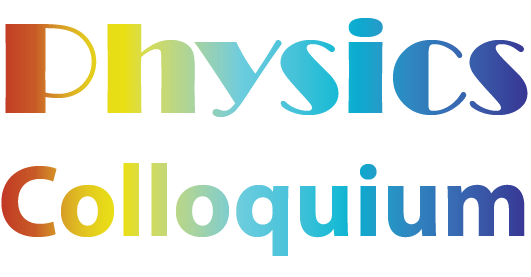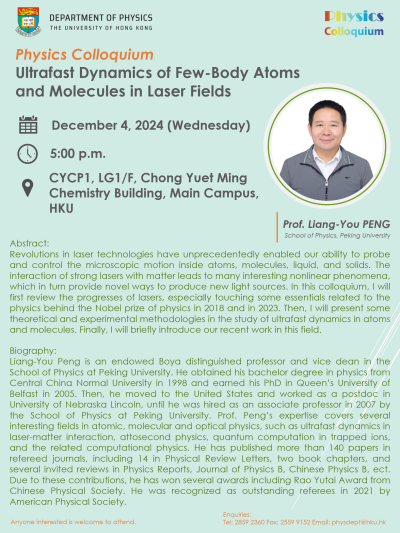
The Physics Colloquium has been arranged regularly since the fall semester of 2021. The detailed schedule and talk information of this semester are as follows.
For inquiries or suggestions of future speakers, please contact the colloquium working group (Prof. Jane Lixin Dai, Prof. Tran Trung Luu, Prof. Yanjun Tu, Prof. Chenjie Wang, and Prof. Shizhong Zhang).
Wave Dark Matter
Speaker: Prof. Lam HUI
Affiliation: Columbia University
Date: September 11, 2024 (Wednesday)
Time: 5:00 p.m.
Venue: MWT4, 1/F, Meng Wah Complex, Main Campus, HKU, The University of Hong Kong
Poster: Download
Abstract:
In this colloquium, Prof. Hui will discuss the possibility that dark matter is composed of sufficiently light particles that it effectively behaves as a collection of waves. He will review the particle physics motivations and the rich wave phenomenology, and discuss the implications for astronomical observations and experimental detection.
Key Reference:
Explore the Time Frontier: from Galileo to Cosmic Antennae
Speaker: Prof. Di LI
Affiliation: Tsinghua University and National Astronomical Observatories of China
Date: September 25, 2024 (Wednesday)
Time: 5:00 p.m.
Venue: MWT4, 1/F, Meng Wah Complex, Main Campus, HKU, The University of Hong Kong
Poster: Download
Abstract: Human's perception and philosophy of the cosmos depend on our collective sensors. Modern optical sky surveys in the 20th century gave rise to the concept of dynamic Universe, the forefront of which currently is situated in radio bands and manifests itself as fast radio bursts (FRB). FRB researches have been awarded the 2023 Shaw prize and the 2024 Marcel Grossman Award. We built the largest radio telescope, namely, the Five-hundred-meter Aperture Spherical radio Telescope (FAST), which has been leading the field of characterizing repeating FRBs ever since the its inception in 2020. With close to 100 FAST-based papers on FRBs, including 5 on Nature and 2 on Science, we started to establish an evolutionary picture for FRBs. With compact objects being the leading candidate engine of FRBs, the utter lack of short-time-scale periodicity present a major mystery regarding FRBs' origin. Recently, we invented the Pincus-Lyapunov diagram to help ascertain the stochastic nature of FRBs. The P-L diagram quantify FRBs to be less chaotic than Earthquakes, but way more random, akin to a Brownian motion on the energy-time bi-variate space. This stochastic behavior presumably reflects the young ages of FRBs. To help systematically localize and discover multi-band counterparts, we are building a next generation FRB machine, namely Cosmic Antennae (CA), the aim of which is to increase the discovery rate by orders of magnitude over all current radio telescopes.
Key Reference:
- https://ui.adsabs.harvard.edu/abs/2018IMMag..19..112L/abstract
- https://ui.adsabs.harvard.edu/abs/2022Natur.601...49C/abstract
- https://ui.adsabs.harvard.edu/abs/2021Natur.598..267L/abstract
- https://ui.adsabs.harvard.edu/abs/2024SciBu..69.1020Z/abstract
Unlocking the Deepest Mysteries of the Universe with a Deep Underground Liquid Xenon Observatory
Speaker: Prof. Jianglai LIU
Affiliation: Shanghai Jiaotong University
Date: October 23, 2024 (Wednesday)
Time: 10:00 a.m.
Venue: MWT6, 1/F, Meng Wah Complex, Main Campus, HKU, The University of Hong Kong
Poster: Download
Abstract: Dark matter and neutrinos are elusive neutral matter filling up our Universe. The PandaX (Particle and Astrophysical Xenon) experiment, located in the China Jinping Underground Laboratory under a 2400-m rock overburden, is dedicated to searching for dark matter particles and studying the fundamental properties of neutrinos. In this talk, after an overview, I will present recent results from PandaX, and discuss the future prospects.
Key Reference:
- Dark Matter Search Results from the PandaX-4T Commissioning Run. By PandaX Collaboration (Y. Meng et al.), PRL 127, 261802 (2021)
- First Indication of Solar 8B Neutrino Flux through Coherent Elastic Neutrino-Nucleus Scattering in PandaX-4T, by PandaX Collaboration (Z. Bo et al.), arXiv:2407.10892, PRL accepted
- PandaX-xT: a Multi-ten-tonne Liquid Xenon Observatory at the China Jinping Underground Laboratory, by PandaX Collaboration (A. Abdukerim et al.), arXiv:2402.03596, submitted to SCPMA
Neutron Scattering Studies of Protein Dynamics and its Associated Quantum Effects
(Joint Colloquium of the Department of Physics and the Hong Kong Institute of Quantum Science & Technology)
Speaker: Prof. Xiang-qiang CHU
Affiliation: City University of Hong Kong
Date: November 13, 2024 (Wednesday)
Time: 5:00 p.m.
Venue: MWT4, 1/F, Meng Wah Complex, Main Campus, HKU, The University of Hong Kong
Poster: Download
Abstract: The roles of quantum effects in biological systems have long fascinated biophysicists. Meanwhile, proteins undergo sophisticated motions in space and time, which are believed to ultimately govern the biological function and activities of the proteins. Quasi-elastic neutron scattering (QENS) provides exceptional tools for studying the dynamics of proteins in the time range of picosecond to nanosecond at the molecular level. In this talk, based on our recent work on various biological systems studied by QENS and other techniques, such as inelastic neutron scattering (INS), small angle neutron scattering (SANS), and neutron spin echo (NSE), I will discuss the possibility of using neutron scattering techniques to reveal the quantum mechanical effects, such as tunneling effect in the dynamics of proteins and connect them with protein activities or functions.
High Harmonic Generation in Gases and Liquids using intense mid-infrared sources
Speaker: Prof. Jiro ITATANI
Affiliation: Institute for Solid State Physics, The University of Tokyo
Date: November 20, 2024 (Wednesday)
Time: 5:00 p.m.
Venue: MWT4, 1/F, Meng Wah Complex, Main Campus, HKU, The University of Hong Kong
Poster: Download
Abstract: In high harmonic generation (HHG), the field-driven sub-cycle electron dynamics plays the fundamental role. In the case of gas HHG, the three-step model leads to the cutoff energy scaling of 3.17Up + Ip where Up is the ponderomotive energy and Ip is the ionization potential [1]. This simple relationship has motivated the development of optical parametric amplifies that can produce phase-stable and ultrashort intense pulses in the infrared. We have developed a BiB3O6-based optical parametric amplifier (OPA) system for the generation of intense SWIR pulses (λ~1.6 μm) and extended the spectral range of isolated attosecond pulses to the water window [2]. The hierarchical dynamics of electrons, molecular vibration, and molecular rotation in NO and N2O gases are clearly observed by the transient soft x-ray absorption spectroscopy at the nitrogen K edge (~400 eV) [3].
Further extension of the spectral range of intense OPAs into the medium wavelength infrared (MWIR) region allows the generation of high harmonics in solids and liquids [4], because the associated low photon energy prevents multiphoton excitation followed by destructive avalanche ionization. In the case of liquids, thin flat water jet systems are developed, which allow to study destructive laser-matter interaction at higher intensity than with the solid targets with a high repetition rate (1 kHz) light source. We have observed non-trivial nonlinear optical responses and high harmonic generation in H2O with 3-μm excitation, where strong absorption by OH vibrations co-exist with field-driven electron dynamics.
Key Reference:
- P. B. Corkum, “Plasma perspective on strong field multiphoton ionization,” Phys. Rev. Lett. 71, 1994 (1993).
- N. Ishii et al., “Sub-two-cycle, carrier-envelope phase-stable, intense optical pulses at 1.6 μm from a BiB3O6 optical parametric chirped pulse amplifier,” Opt. Lett. 37, 4182 (2012); N. Ishii et al., “Carrier-envelope phase-dependent high harmonic generation in the water window using few-cycle infrared pulses,” Nature Commun. 5:3331 (2014).
- N. Saito et al., “Real-time observation of electronic, vibrational, and rotational dynamics in nitric oxide with attosecond soft x-ray pulses at 400 eV,” Optica 6, 1542 (2019); N. Saito et al., “Attosecond electronic dynamics of core-excited states of N2O in the soft x-ray region,” Phys. Rev. Res. 3, 043222 (2021).
- F. Lu, P. Xia, Y. Matsumoto, T. Kanai, N. Ishii, and J. Itatani, “Generation of sub-two-cycle CEP-stable optical pulses at 3.5 μm from a KTA-based optical parametric amplifier with multiple-plate compression,” Opt. Lett. 43, 2720 (2018).
Ultrafast Dynamics of Few-Body Atoms and Molecules in Laser Fields
Speaker: Prof. Liang-You PENG
Affiliation: School of Physics, Peking University
Date: December 4, 2024 (Wednesday)
Time: 5:00 p.m.
Venue: CYCP1, LG1/F, Chong Yuet Ming Physics Building, Main Campus, The University of Hong Kong
Poster: Download
Abstract: Revolutions in laser technologies have unprecedentedly enabled our ability to probe and control the microscopic motion inside atoms, molecules, liquid, and solids. The interaction of strong lasers with matter leads to many interesting nonlinear phenomena, which in turn provide novel ways to produce new light sources. In this colloquium, I will first review the progresses of lasers, especially touching some essentials related to the physics behind the Nobel prize of physics in 2018 and in 2023. Then, I will present some theoretical and experimental methodologies in the study of ultrafast dynamics in atoms and molecules. Finally, I will briefly introduce our recent work in this field.
Key Reference:
- T. Brabec and F. Krausz, Rev. Mod. Phys., 72, 545 (2000).
- F. Krausz and M. Ivanov, Rev. Mod. Phys., 81, 163 (2009).
- L.-Y. Peng, W.-C. Jiang, J.-W. Geng, W.-H. Xiong, and Q. Gong, Phys. Rep., 575, 1-71 (2015).
- W.-C. Jiang, W.-H. Xiong, J.-W. Geng, Q. Gong, and L.-Y. Peng, Chapter 5 in Advances of Atoms and Molecules in Strong Laser Fields, Ed. Y. Liu, World Scientific (2015).
- W.-H. Xiong, L.-Y. Peng, and Q. Gong, J. Phys. B, 50, 032001 (2017).
- M.-X. Wang, S.-G. Chen, H. Liang, L.-Y. Peng, Chin. Phys. B, 29, 013302 (2020).





